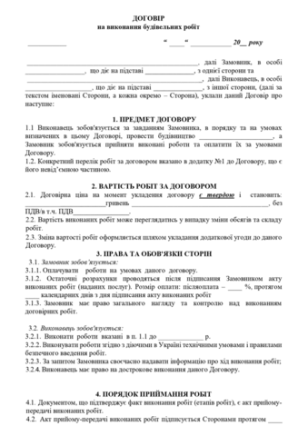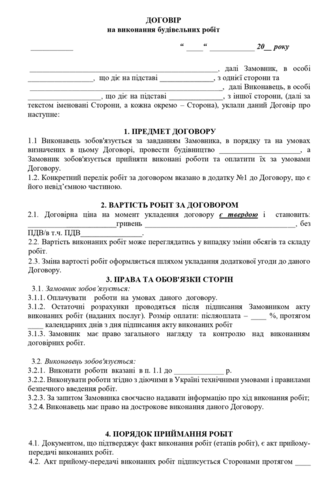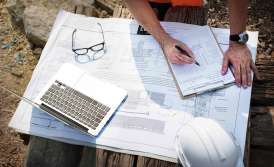How to legalize an extension to a private house: construction passport and commissioning
Cost of services:
Reviews of our Clients
... our work on joint projects assured us of your high level of professionalism
When carrying out an extension to a private home that involves altering its geometric dimensions, and area, and entails interventions in load-bearing structures, you are legally conducting a property reconstruction.
Engaging in such work implies the necessity of obtaining the required permits, and upon the completion of the construction, the property must be put into operation.
To undertake a reconstruction, it is essential to obtain a building passport. To acquire this document, the property owner must apply to the authorized urban planning and architectural authority with the following:
- An application.
- Title deeds for the land plot and the house.
- Notarized consent from co-owners.
Note: If this consent is not notarized, all co-owners must jointly apply.
Furthermore, the documentation package should include:
- A land plot development intent plan.
- Information concerning any cultural heritage assets on the land plot.
- Information about any usage restrictions for the land plot.
The land plot development plan should include the following information:
- The placement of buildings and structures on the land.
- Distances from buildings to the boundaries of neighboring land plots and any structures on them, as well as from engineering networks and facilities.
- Details about the building facades, floor plans, and roof shapes.
- Visual representations of the cross-sections of the proposed buildings or structures, along with their dimensions.
- A comprehensive list of engineering systems, including any planned autonomous systems.
- Designations for red lines, development regulation boundaries, access points, and connections to engineering networks.
Typically, the development plan is presented in an informal format, but it usually encompasses:
- An explanatory note.
- A schematic master plan that provides an overview of how the objects will be laid out on the land.
- Floor plans, elevations, and vertical sections of the buildings, as well as any additional structures like utility buildings and garages.
Many clients attempt to create such a plan on their own but often face rejection when applying for a building permit due to various reasons. For instance, they might not have included distances to neighboring buildings, failed to adhere to setback requirements, or violated sanitary and fire safety regulations. Another common mistake is neglecting to account for existing buildings and engineering networks on adjacent land plots and the distances to them. Development regulations, especially protective zones crossing through the plot, may not be considered or might be disregarded during the planning process.
Of course, when we assist with the legalization of extensions or reconstructions, we not only help with document submission but also their development. In this way, the architectural authority will have no legal grounds to deny the issuance of a building permit. Our legal team will ensure that everything is prepared in compliance with legal requirements and to the highest standards.
You may also like: Legalization of Unauthorized Construction in Ukraine
How to legalize an extension if the owner didn't obtain the necessary permits?
There are several ways to legitimize an extension to a private house, as detailed in the article.
In this section, we will focus on a common approach: utilizing building amnesty. It's important to note that, as of August 2023, this method allows you to put unauthorized constructions into operation without incurring penalties. However, it's crucial to be aware that this situation may change when Law 5655 on urban planning reform is signed by the President.
Upon the adoption of this bill, there will be an administrative fee of approximately 19,000 UAH for putting unauthorized constructions into operation. Hence, it is advisable not to postpone taking advantage of this service before the cost significantly escalates.
The key criteria for qualifying for building amnesty are as follows:
- Possession of property rights or land use rights for the land plot.
- Alignment of the land plot's designated purpose with the construction.
- Assignment of a cadastral number to the land plot.
- Ensuring that the construction was carried out without violations of construction norms and regulations.
We can assist you in determining if you meet the criteria for building amnesty and support you in the process of legalizing your extension.
You may also like: Real Estate Commissioning: Essential Information
Illegal extensions and multiple co-owners: How to put it into operation if one co-owner disagrees?
Clients often approach us seeking to legalize unauthorized constructions and to divide their respective shares, especially when disputes or strained relationships exist with another co-owner. Regrettably, this is a common scenario.
According to the law, when there is joint ownership, all co-owners must act in mutual agreement, meaning they must collectively and simultaneously take action. When conflicts arise among co-owners, there are two avenues to resolve the situation: through negotiations or legal proceedings.
It's crucial to recognize that only real estate that has been put into operation can be physically divided. Therefore, the typical procedure involves first ensuring the real estate is operational and subsequently dividing the shares.
How do the equitable shares of co-owners change when an extension leads to alterations in the property's areas and results in a change in each person's share size?
This is another common scenario that our clients often face.
For example, let's consider a case involving our clients. They jointly owned a house, with one half belonging to a brother and the other half to a sister. The brother expanded the house with an extension, significantly increasing the area he utilized. However, this extension was carried out without the necessary permits (lacking the authorization for construction work, as confirmed through a declarative process - the submission of a Notice of Commencement of Construction Work).
We devised a strategic plan and executed the project as follows:
- We legalized the unauthorized construction by going through the comprehensive process of creating a building passport and obtaining the required permits (the project did not qualify for building amnesty due to the construction date).
Note: An important point to consider is that after the property has been put into operation, and before registering ownership rights in the registry, written consent from all co-owners is required if the ownership shares remain unchanged. However, if, as a result of the reconstruction, the parties agree to alter and redistribute their shares, they must formalize the corresponding agreement with a notary, specifying the redistribution and changes in ownership percentages. In our case, after the reconstruction, the shares were adjusted to ¼ and ¾ through mutual agreement.
- We notarized the agreement for the division of the real estate.
- We divided the land plot, assigning individual cadastral numbers and registering land rights in the property registry.
- We obtained a conclusion from the BTI (Bureau of Technical Inventory) regarding the feasibility of the division.
- We created new technical documents for the properties.
- We secured two different addresses and registered ownership rights in the property registry.
As you can see, there's nothing that cannot be achieved. However, for cost and time efficiency, it's crucial to start with an initial audit, develop a strategic plan, and proceed with the project step by step.
Every construction endeavor should commence with obtaining the necessary permits. It's not advisable to construct first and then seek to "legalize" afterward – this is a common error that can prove to be more costly and time-consuming. We have repeatedly emphasized that not everything that is built can be seamlessly put into operation, even through the court.
That's why we offer a complete "turnkey" construction documentation service. Our services encompass:
- Consultation and the development of a project implementation roadmap.
- Development of an intention development plan.
- Procurement of the requisite permits.
- Compilation of technical property passports.
- The process of property commissioning.
- Allocation of a postal address.
- Registration of property rights, including the acquisition of an extract from the State Register of Property Rights, and more.
Our clients






